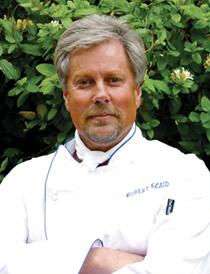 |
| Robert Kincaid |
|
Robert Kincaid started working in restaurants at the age of 15. He apprenticed for three years at the Benson Hotel in Portland, Oregon and then for two at the Olympic in Seattle. Later, he worked at the New Otani Hotel in Tokyo, at Tantris in Munich, and at Ernie’s in San Francisco.
After years of refining his skills as a chef and learning the restaurant business, he became the chef and partner of Caravan restaurant in Carmel Valley. By November, 1979, he was ready to go out entirely on his own and opened Fresh Cream on Cannery Row. The name, according to Robert, is meant to exemplify his insistence on the supreme freshness of provender.
Robert sold Fresh Cream in 1989 and returned to Portland where he opened another restaurant. Pining for the Monterey Peninsula again, he returned in 1994 and opened Robert’s Bistro in the Carmel Crossroads. Fodor’s briefly described Robert’s Bistro this way:
At chef-owner Robert Kincaid's French Bistro, dried sage and lavender hanging from exposed ceiling beams, painted floors, and ochre-washed walls will make you feel as if you've stepped into an old farmhouse in Provence. The menu stresses seasonal ingredients, cassoulet made with white beans, duck confit, rabbit sausage, and garlic prawns is always on the stove. Leave room for dessert, particularly the soufflé with lemon and orange zest or the chocolate bag with chocolate shake, a masterful invention. Reservations essential.
A review in the October 29, 1998 issue of Monterey’s Coast Weekly better captured the essence of Robert Kincaid’s style and foreshadowed his later success at the Hart Mansion:
A rose is a rose is a rose is the phrase that comes to mind as you chart the evolution of Robert Kincaid's cuisine. Holding strongly to roots grounded in the traditions of classical French cuisine while expanding on them in a way that invites an unintimidating sense of ease, Kincaid''s Bistro, begun five years ago at the Crossroads in Carmel, continues to flower.
You might say that Kincaid pulled off what became his own hard act to follow. As the originator of Fresh Cream, a local fine dining institution that continues to thrive after almost 20 years—and still carries the mark of his influence—doing it all over again might be considered a pretty tall order. After a five-year hiatus that spirited him home to Portland, Ore. and another restaurant venture, Kincaid was drawn back to the Peninsula to take on an opportunity that sounds at first, in some ways, almost like competing against yourself.
“From the start, there was a perception that was associated with the name,” Kincaid explains, “an expectation level. I wanted to move away from being labeled just a “special occasion” destination to a concept with more latitude. As an upscale bistro, you’re able to encompass many things; the food can be artistic and thoughtful without being limited and without becoming rough or rustic. At the same time, the atmosphere is comfortable and relaxed.”
Kinkaid’s easy cadence with himself and his cuisine follows a career that was honed by an early three-year apprenticeship that lead to cooking positions in top-flight establishments worldwide. After moving up the ladder with stints in Munich, Tokyo and San Francisco, the career obligation to re-locate became less attractive, and an opportunity on the Peninsula was there. Finding his own style came next.
It’s inevitable that certain dishes become a chef’s trademark, part of a select repertoire that might occasionally be updated but can hold their own season after season. Such is the case with Kincaid’s signature roast confit of duck in sweet wild cherry sauce, accompanied by a gaufrette potato basket filled with dauphine potatoes. Or the quenelle of chicken mouselline served in an artichoke bottom and garnished with a julienne of apples, pecans and blue cheese with red and white wine butter sauces.
It becomes hard to choose between classic fare like the rack of lamb, roasted in a crust of mustard bread crumbs, and Kinkaid’s own style of carne asada, the tequila-marinated grilled filet of beef, teamed up with salsa and guacamole.
Lunch is a prix fixe selection of three starters and five-or-so entrees and a couple of Kinkaid’s blow-out-all-the-stops desserts, a menu that changes twice a month.
Staying true to timeless classics while branching out to have some fun with the rest describes this well-rounded menu. Whichever direction your palate sends you, the integrity of flavor is intact. “Cooking is no doubt an art form,” Kinkaid reflects: “There’s a lot of ego gratification about it. That’s one of the hooks. But, still having that love, keeping that integrity is the thing. It’s an arduous task,” he smiles, “but one that must be held dear.”
|
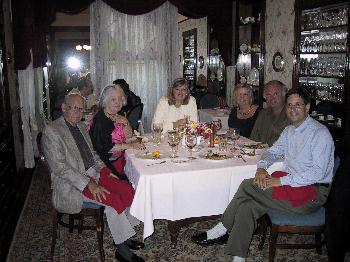 |
| Al & Edna, Lori & Bob Kohn, Louise & Lad Wilson |
|
Bob Kohn and his wife Lori were looking to invest in a commercial building on the Monterey Peninsula in the fall of 1999 when their real estate agent, Lad Wilson, suggested they take a look at the Hart Mansion in Pacific Grove. The Kohn’s recalled having dined at Gernot’s restaurant some years before, and the opportunity of owning such a prized, historical building intrigued them.
Bob was born Robert Henry Kohn on February 13, 1957. At the time, his parents, Al and Edna Kohn, were living in Forest Hills, New York with their first two sons, Ted (b. June 29, 1945) and Matt (b. October 17, 1948). Ted, and his wife Joanne, live in Tarzana, and have two children, Beth Sanchez and Todd. Matt, and his wife Sharon Lester Kohn, live in Santa Monica, California, and also have two children, Frankie and Samuel.
|
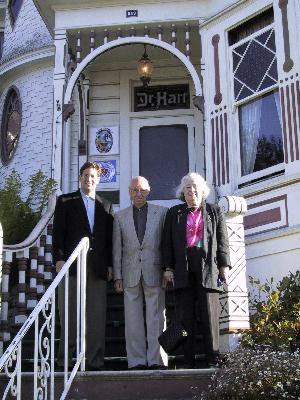 |
| Bob with parents, Al & Edna Kohn |
|
Bob’s father, Al Kohn (b. March 23, 1919) is a 70-year veteran of the music business. Al was born in the Bronx and lived for a time in Rockaway, N.Y. While he was a teenager, he and three friends formed a band called, The Crestonians, after the name of school, Creston Junior High School in the Bronx, and played at various venues in the Catskill Mountains. He was a graduate of DeWitt Clinton High School in the Bronx and later attended New York University.
Al worked as an arranger for several major orchestras, including those of Paul Whiteman, Abe Lyman, Orrin Tucker and others. He also arranged nightclub revues at Lou Walter’s Latin Quarter, Billy Rose’s Diamond Horseshoe, and the Steel Peer Music Hall in Atlantic City, New Jersey. He was a member of the creative team at Hummert Radio Features and was the key arranger for some of the syndicate’s major network radio programs including Waltz Time and Manhattan Merry-Go-Round.
During World War II, Al was a band leader in the Air Corp, stationed in Rome, New York. Irving Berlin tapped him to orchestrate his all-soldier show, This Is The Army. After the war, he arranged the music for several major television shows, including those of Milton Berle, Katherine Murray, George Jessel, Martha Raye, and Jane Pickens. He also arranged or conducted for Bob Hope, Billy Rose, Jerry Vale, and many others.
In the 1960s, Al was the U.S. representative for the London-based Francis, Day & Hunter music publishing organization. He also worked for Robbins Music Corp. and for Mitch Leigh, the writer and producer of Broadway plays, including Man of La Mancha. In 1971, Al became Vice President of Licensing for Warner Bros. Music, which moved Al, Edna and a 14-year old Bob to Los Angeles. He retired in 1992.
Al’s brother, Roy Kohn (b. August 24, 192?), lives with his wife Gloria in Tarzana, California, just a block away from Edna and Al. Al and Roy’s parents were Frank and Ida Kohn. Frank’s father, Leopold was from Hungary and came to America with his family at the turn of the last century.
Bob’s mother, Edna (b. June 28, 1918) was the daughter of Samuel and Rose Stein. Edna has a younger brother, Barney (b. ___________) who lives in St. Petersberg, Florida. Her older brother, Harold (b. ___________) passed away on ________. Harold and his wife, Betty (b. _______, d_______) had two children, Judy Bank and Lee Stein. Judy had two children, Tony Bank and Patty Bank Finkelstein, all of Los Angeles. Lee Stein is an award-winning producer of movie trailers (i.e., those one minute advertisements you see as “coming attractions”). Barney has three sons, Richard, Lloyd, and Aaron.
|
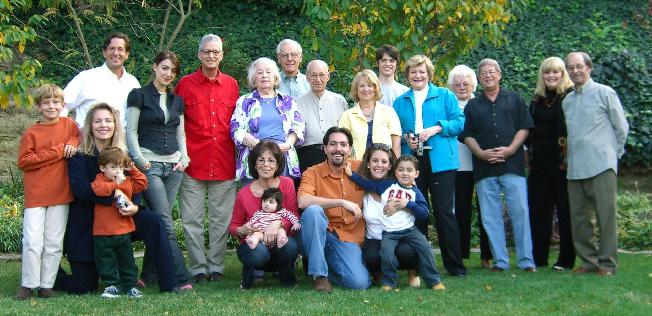 |
| The Kohn Family |
|
|
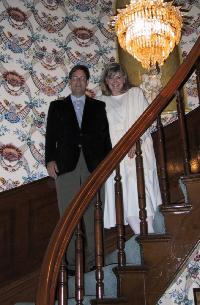 |
| Bob & Lori Kohn |
|
Lori Oliver Kohn was born Lori Jean Oliver to Leonard (b. October 18, 1920, d. May 17, 2003) and Lola Oliver (b. April 11, 1923). Until 2007, Lola lived at 671 Laurel Avenue in Pacific Grove, a house purchased by the Bob and Lori in 2001. Lori’s older sister Julie Kahn, has a son, Michael; both live in Los Angeles. Lori’s younger sister, Cindy Oliver has three children, Whalen, Nicole, and Tyler, all of whom live in Portland, Oregon.
In 1974, Bob was graduated from Birmingham High School in the San Fernando Valley, a school whose alumni include Sally Fields, Michael Milkin, Micheal Ovitz, Bob Saget, and Internet financier, Bill Gross. Bob graduated California State University, Northridge with a degree in Business Administration, and from there he went on to attend Loyola Law School in Los Angeles, being admitted to the California Bar in December, 1981.
Upon graduating law school, Bob went to work for the Law Offices of Milton A. “Mickey” Rudin in Beverly Hills, California, an entertainment law firm whose clients included Frank Sinatra, Liza Minelli, and Cher. He also served as associate editor of the Entertainment Law Reporter.
In 1983, he became corporate counsel for Ashton-Tate Corp., a developer of microcomputer software, including the popular dBASE II database management software. Thereafter, he worked as associate general counsel for Candle Corporation, a maker of mainframe software, recently acquired by IBM.
Bob and Lori were living in a condominium on Roxbury Drive in Beverly Hills when they had their first daughter, Katie Beth, on January 21, 1986. In March, 1987, they moved to Santa Cruz, California, where Bob was recruited to join a fast growing software company started by the flamboyant French entrepreneur, Philippe Kahn. Borland International was known for its Sidekick software, as well as it s Quattro spreadsheet, and Turbo line of software development software. Bob served as Borland’s vice president and general counsel until September 1996. During that time, he was involved in several high profile Silicon Valley legal proceedings, including Lotus v. Borland, a case which Bob took all the way to the U.S. Supreme Court and won.
A year after arriving in Santa Cruz, the Kohn’s had their second child, Joseph Frank (b. July 13, 1988). In 1992, Bob completed a book he had been writing with his father on the business and legal aspects of the music business. Kohn On Music Licensing was published by Prentice-Hall Law & Business. USA Today would later call the book, “the bible on legal issues in the music world.” The book, now published by Aspen Law & Business, is in its third edition.
For three years, Bob spent one evening a week teaching corporate law at Monterey College of Law. His essay, “Mind and Brain: The Genius of Fortune,” submitted for a philosophy contest judged by the late Mortimer J. Adler, was judged the winner and published in the 1994 edition of The Great Ideas Today.
In 1996, Bob joined the Silicon Valley startup, Pretty Good Privacy, Inc., makers of the notoriously strong encryption program, PGP. After PGP was sold to Network Associates, Bob founded EMusic.com, Inc. (NASDAQ: EMUS), the pioneering MP3 music-download service, where he served as chairman until the company was sold to Vivendi/Universal in June 2001. Bob and his partner Gene were profiled in Forbes Magazine [GET DATE] and on the front page of the business section of USA Today (November 4, 1998).
Upon the sale of EMusic, Bob, with comedian George Carlin and business partner Marshall Berle, founded a comedy record company, called Laugh.com. Other shareholders included the late Milton Berle, Shelley Berman, Bill Dana, Phyllis Diller, Norm Crosby, Rich Little, Jackie Martling, Jonathan Winters, and San Francisco’s well-known “Comedy Coach” (and high school buddy of Bob’s), Neil Leiberman. Bob serves as the company’s chairman and his brother Ted is vice president of operations. For several months after the Kohn's purchase of the Hart Mansion, the building was used as an informal office for Laugh.com.
|
|
Bob and Gernot came to terms quickly and by the Fall of 1999, Bob and Lori Kohn were the proud owners of a 19th Century Victorian building, together with all of the provisions necessary to operate a first class restaurant, down to the kitchen appliances, plates, silverware, and other dining room provisions. Bob’s vision for the building was to lease the first floor to a restaurateur and maintain the upstairs as a place where he and a few friends could hang out and smoke cigars.
With the understanding that Bob would try to find a suitable restaurateur to assume the business, Gernot continued his business until April, 2000. During this time, Bob was still fully engaged with EMusic, traveling extensively to Europe, New York, and Los Angeles. Rather than make a hasty decision that might adversely affect their investment in the building, the Kohn’s decided to let Gernot retire without bringing in a replacement tenant. Except for a file cabinet containing documents concerning Laugh.com, the building stood vacant for the rest of 2000 and all of 2001.
In the Kohn’s holiday newsletter, The Kohn Times, of December 25, 2000, Bob joked about their dilatory plans for the building:
Kohn’s Buy 100 Year Old
Victorian “Dr. Hart” Mansion
(Pacific Grove, CA) – Lori and Bob now the proud owners of a 19th Century historical monument, the Victorian Mansion that stands on the corner of Lighthouse at 19th Street in Pacific Grove, California. Built in 1894 by a Dr. Hart, the Queen Anne-style building most recently housed Gernot’s restaurant before the owner retired and sold the building to the columns. “We have not yet announced plans for the building,” said Bob Kohn, who is still disappointed by the city planning commission's denial of his request to convert the property into an oil refinery. Hopes for using the building is a brothel were also dashed, when a 100-year-old city ordinance outlawing prostitution was discovered. The Kohn’s are now looking for a responsible restaurateur who would bring elegance and style to this classic Pacific Grove location. “We’re hoping to lure a California Cuisine that has the style of a Le Cirque and the taste of a Burger King," noted Bob.
When EMusic was sold in June, 2001, Bob finally had some time to turn his attention to the Hart Mansion. In September, 2001, he engaged a resident of Marina to paint the second and third floors of the building and began making inquiries about repairing the roof and other matters.
|
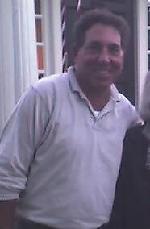 |
| David Berkowitz |
|
On Sunday, December 2, 2001, Bob received a call from Pebble Beach resident, David Berkowitz. David had been a friend of the Kohn family since the late 1960’s, when he attended Sullivan County Community College in upstate New York with Bob’s oldest brother Ted. David moved to Los Angeles and co-founded MusicPlus, a successful chain of record stores in Southern California.
After selling MusicPlus to the Wherehouse record chain, he moved to Pebble Beach and acquired a home on Venadero Street, which he renovated into a beautiful Swiss-style, stone chalet he called “Bedford Falls.” One of the most intriguing features of Bedford Falls was its beautifully landscaped backyard which featured a two-level green surrounded by nine tees from which to pitch and put.
|
 |
| Bergerac's Cassoulet Award |
|
David had come to know Lucie Bergerac Campos who discovered David’s connection with Bob Kohn. One day in November, 2001, Lucie called David for a favor. Lucie wanted to give her father, Ray Bergerac, a special birthday present: the award he received in France for his cassoulet, the four-tile plaque still mounted next to the front door of the Hart Mansion.
David got in touch with Bob and on Sunday morning, December 2, 2001, David, Bob, Lucie, and her husband, met at the Hart Mansion where Lucie explained her purpose. Initially, Bob was reluctant to change anything that might be of historical significance to the building, but he never expressed that to Lucie, who seemed intent on her designs for the plaque.
Perhaps sensing Bob’s hesitancy, Lucie provided a tour of the mansion, pointing out features of significance and relating stories of her childhood. As the four entered the building, she showed how the “Dr. Hart” stained-glass transom reflected properly in the foyer’s mirror. When they reached the third floor, they entered her gabled room and then her small closet, the walls of which were still covered with pencil-written doodles of love between Lucie and her boyfriend of that time, who was later to become her husband. The closet was witness to many teenage expressions of intimacy, but nothing more than kissing and smooching, occurring between the times Lucie’s mother marked off her height on the growth chart that still appears by the door of the closet.
Charmed by Lucie’s anecdotes, now delighted by the prospect of Ray Bergerac being reunited with such a treasured prize, and being obliged to David for his many kindnesses to his family, Bob agreed to let Lucie have the plaque. The decision earned Bob a measure of good kharma which didn’t take long to have its affect.
Learning that the building remained tenantless, Lucie asked Bob if he had considered calling Robert Kincaid, the owner of Robert’s Bistro in the Crossroad shopping center in Carmel, who she thought might be interested in leasing the property for a restaurant. She gave Kincaid’s mobile phone number to Bob who called him the next day.
At 11am on Thursday, December 6, 2001, Robert Kincaid met Bob at the Hart Mansion. Bob had dined at Robert’s Bistro several times, most recently when his parents visited from Los Angeles earlier that May. They toured the building and almost immediately the two seemed to know, as the movie says, that this was to be the beginning of a beautiful friendship.
On December 19, Bob and Robert met again at mansion and came to terms. When Bob learned Robert was living in a rented home in Pacific Grove, Bob suggested that he lease the upper apartment for his residence and it was all settled. Bob’s dream of a cigar bar went up in smoke, but with Robert living upstairs, he knew the building would be well looked after at all hours of the day and night.
In the meantime, Bob and his wife Lori had long since been planning a New Year’s Eve party at the Hart Mansion for about forty guests. Chris Axton, the former owner of the Bully III restaurant in Carmel, prepared the dinner, and the party goers brought in the New Year with dancing and hangovers.
The lease was signed on ____ and Robert moved into the upstair’s residence with his son, _____. He thereupon began preparations for opening the new restaurant, making some improvements to the kitchen, replacing some worn out appliances, and acquiring two large grease traps to comply with local ordinances. Kohn had Pete Scudder of Scudder Roofing minister to the roof and Kincaid had the building re-painted white with a cream-colored trim. Meanwhile, Kincaid obtained the inspections appurtenant to operating a restaurant, and obtained the permit necessary to serve wine and beer.
|
|
Kincaid chose the name, Robert’s White House restaurant and erected an exquisite sign where signs for Maison Bergerac and the Antique Castle hung before it. In July, 2004, Lori Kohn replaced the lamp fixtures on the free-standing sign in front of the building. The new English-style lamps are similar to the ones used at the time the building was known as the Antique Castle.
|
 |
| Robert's White House |
|
|
|
On May 28, 2002, at the request of the Kohn's, Kincaid prepared the fare for a pre-opening, private party celebrating the 50th birthday of the Kohn family friend, Marilyn Schultz, a long-time Pacific Grove resident and employee of City of Pacific Grove development and planning department.
|
On June 18, Robert’s White House restaurant was open for business. Kincaid offered a prix fixe menu, offering for $19.95 an appetizer, soup or salad, and entree. He soon raised the price to $22 and later $37. Our favorites included his Smoke Salmon Rose with Avocado Vinegrette and Lobster Ravioli with Sauce Nantua appetizers, and his Crisp Roast Duckling with Black Currant Sauce , Roast Rack of Lamb Dijionnaise, and Holland Dover Sole Buerre Blanc. For dessert, Robert's apple tartan and "chocolate bag"--solid dark chocolate in the form of a small lunch bag filled with rich chocolate milk shake--were perennial favorites.
“Commander in Chef”—a clever play on Kincaid’s culinary acclaim and his new restaurant’s name—was the headline of a rave review by Sue Fishkoff appearing in the July 11, 2002 issue of the Monterey Coast Weekly:
"An initial visit to The White House last week confirmed that Kincaid, staff and menu have made the move to P.G. without missing a step. At 6pm on a Wednesday night, the place was packed. Many of the diners were Kincaid regulars who had followed him over the hill, hoping to find the same culinary excellence. If our meals that night were any indication, they will not be disappointed.
"Because the small size of the kitchen and limited storage areas, Robert opted for the same solution Ray Bergerac found successful: a reasonably priced prix fix menu from which diners choose from among a half-dozen appetizers, a second course of soup or a salad, and an entrée from among six or seven selections. As Fishkoff observed,
"Both appetizers-indeed, all three courses-were smaller than diners hereabouts are used to. As we progressed through the meal, the wisdom of that choice became clear. My Caesar salad was just three leaves of Romaine with a slice of prosciutto on top, and my companion’s spinach salad in a light vinaigrette with fried Brie and candied pecans was equally petite; when we were through, we were primed for the entree rather than over-stuffed.
"The menu changes each evening and, in addition to the prix fix meal, Robert usually offers from one or more of his full-portion signature dishes—rack of lamb, roast duck, Dover sole (which is filleted at table) or filet mignon—in lieu of the set menu of entrees, for an additional charge."
|
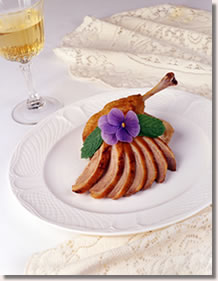 |
| Kincaid's Special Duck |
|
|
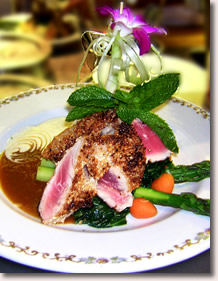 |
| Kincaid's Seared Ahi |
|
|
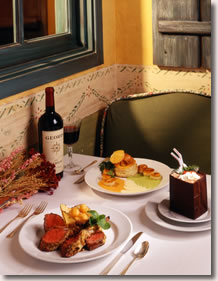 |
| Kincaid's Signature Chocolate Bag |
|
|
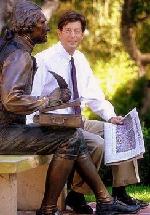 |
| Bob Kohn |
|
While vacationing with Lori in New England during the summer of 2002, Bob had been reading the New York Times every day when he noticed something strange: The news pages were being written in a way that clearly reflected and supported the views expressed in the paper’s editorial pages. Bob didn’t always disagree with the Times’s editorial views on matters, but he began to recognize what he believed was a clear pattern of journalistic malfeasance by the editors of the news pages.
During that vacation, Bob started taking notes for a book which was to be published the following year under the title, Journalistic Fraud: How the New York Times Distorts the News (WND Books, 2003). The book received critical acclaim for its detailed exploration of objectivity in journalism and soon Bob was invited to appear on virtually every syndicated radio talk show in the country, including the Don Imus show.
By Spring, 2004, Bob had appeared twice on Fox News’ O’Reilly Factor and seven times on MSNBC’s Scarborough Country. At its height, the book reached No. 38 on the best seller list posted on Amazon.com.
In 2000, Bob was invited to join the board of directors of Borland Software Corporation (NASDAQ: BORL) and was elected Vice Chairman of the company in 2001. He also currently serves on the advisory boards of a number of high tech start-up companies, including Visible Path, EID Passport, and Alio TV. He has also served as an expert witness in several music-related cases, and from time to time provides consulting services in the entertainment and high tech industries.
In May, 2005, Bob resigned from Borland's board and founded RoyaltyShare, Inc., a leading provider of web-based content management and royalty processing services for the entertainment industry. RoyaltyShare was financed by Trident Capital (Palo Alto) and later by Bertelsmann Digital Media Investments (BDMI). Bob serves the company as its Chairman & CEO, and he is joined on the Board with Don Dixon of Trident and Richard Sarnoff of BDMI.
In 2006, Katie Kohn graduated New York Univerity NYU with a degree in cinema studies and by the end of 2007 she completed her masters degree in related studies at the University of London. In 2006, Joey Kohn graduated Robert Louis Stevenson School in Pebble Beach, and is majoring in videogame design at the Viterbi School of Engineering at the University of Southern California. After the sale of Maison Bergerac, Raymond and Betty Bergerac moved to Camel Valley where they operated a small vineyard. Later, they moved back into Carmel-by-the-Sea where they were enjoying their retirement years together until Raymond's passed away in October, 2007. A few months later, Frank Bruni, restaruant critic of The New York Times, memorialized the passing of a great chef and his memorable restaurant here and here.
In May, 2007, after a successful 5-year run, Robert's White House restaurant closed. Robert Kincaid is working as the chief chef of Monterey's venerable Capitol Club. Soon thereafter, the Kohn's began preparations for the sale of the property, listing it with Sotheby's.
|
|